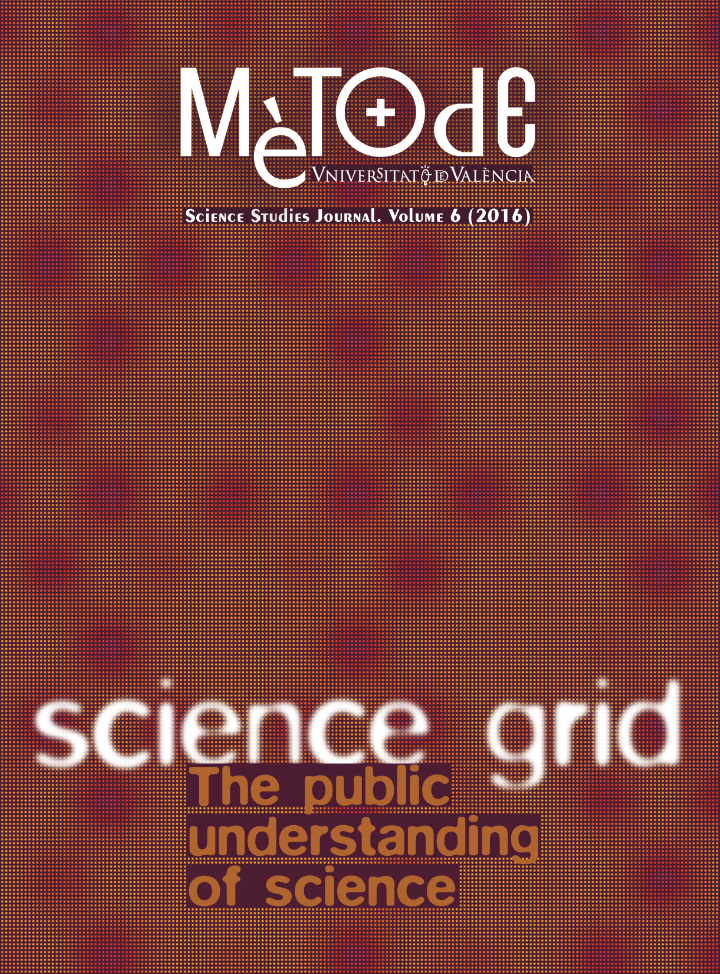One of the foremost experiments of the twentieth century: Stanley Miller and the origin of prebiotic chemistry
DOI:
https://doi.org/10.7203/metode.6.4994Keywords:
amino acids, spark discharge, reducing atmosphere Abstract
Abstract
Stanley Miller is best known for his classic 1953 experiment on the synthesis of early Earth organic compounds, in the context of the origins of life. However, he did several other experiments that are lesser known and, in some cases, have never been published. The finding in 2007 that Miller had archived dried solutions from his 1950s experiments offered the opportunity of analyzing the products of his early experiments using modern day state-of-the-art techniques. These results, along with Miller’s results, have provided an inventory of the large variety of compounds that include amino acids, amines, simple peptides, hydroxy acids, simple hydrocarbons and urea, which can be synthesized under simulated early Earth conditions.
 Downloads
Downloads
 References
References
Bada, J. L. (2013). New insights into prebiotic chemistry from Stanley Miller’s spark discharge experiments. Chemical Society Reviews, 42, 2186–2196. doi: 10.1039/c3cs35433d
Bada, J. L., & Lazcano, A. (2002). Miller revealed new ways to study the origins of life. Nature, 416, 475. doi: 10.1038/416475a
Bada, J. L., & Lazcano, A. (2003). Prebiotic soup – Revisiting the Miller experiment. Science, 300, 745–746. doi: 10.1126/science.1085145
Bada, J. L., & Lazcano, A. (2012). Stanley L. Miller (1930-2007): A biographical memoir. Retrieved from the National Academy of Sciences (USA) website: http://www.nasonline.org/memoirs
Ball, P. (2005). Elegant solutions. London: Royal Society of Chemistry. doi: 10.1039/9781847552600
Burton, A. S., Stern, J. S., Elsila, J. F., Glavin, D. P., & Dworkin, J. P. (2012). Understanding prebiotic chemistry through the analysis of extraterrestrial amino acids and nucleobases in meteorites. Chemical Society Reviews, 41, 5459–5472. doi: 10.1039/C2CS35109A
Cavendish, H. (1788). On the conversion of a mixture of dephlogisticated and phlogisticated air into nitrous acid, by the electric spark. Philosophical Transactions of the Royal Society of London, 78, 261–276.
Fekete, B. M., Vörösmarty, C. J., & Grabs, W. (2002). High‐resolution fields of global runoff combining observed river discharge and simulated water balances. Global Biogeochemical Cycles, 16(3), 1–10. doi: 10.1029/1999GB001254
Johnson, A. P., Cleaves, H. J., Dworkin, J. P., Glavin, D. P., Lazcano, A., & Bada, J. L. (2008). The Miller volcanic spark discharge experiment. Science, 322, 404. doi: 10.1126/science.1161527
Löb, W. (1913). Über das Verhalten des Formamids unter der Wirkung der stillen Entladung Ein Beitrag zur Frage der Stickstoff‐Assimilation. Berichte der deutschen chemischen Gesellschaft, 46(1), 684–697.
Miller, S. L. (1953). A production of amino acids under possible primitive earth conditions. Science, 117, 528–529. doi: 10.1126/science.117.3046.528
Miller, S. L. (1955). Production of some organic compounds under possible primitive earth conditions. Journal of the American Chemical Society, 77, 2351–2361. doi: 10.1021/ja01614a001
Miller, S. L. (1957). The mechanism of synthesis of amino acids by electric discharges. Biochimica et Biophysica Acta, 23, 480–489. doi: 10.1016/0006-3002(57)90366-9
Miller, S. L., & Urey, H. C. (1959). Organic compound synthesis on the primitive Earth. Science, 130, 251–251. doi: 10.1126/science.130.3370.245
Parker, E. T., Cleaves, H. J., Dworkin, J. P., Glavin, D. P., Callahan, M., Aubrey, A., Lazcano, A., & Bada, J. L. (2011). Primordial synthesis of amines and amino acids in a 1958 Miller H2S-rich spark discharge experiment. Proceedings of the National Academy of Sciences, 108, 5526–5531. doi: 10.1073/pnas.1019191108
Parker, E. T., Zhou, M., Burton, A. S., Glavin, D. P., Dworkin, J. P., Krishnamurthy, R., Fernández, F. M., & Bada, J. L. (2014). A plausible simultaneous synthesis of amino acids and simple peptides on the primordial Earth. Angewandte Chemie, 126, 8270–8274. doi: 10.1002/ange.201403683
Peltzer, E. T., Bada, J. L., Schlesinger, G., & Miller, S. L. (1984). The chemical conditions on the parent body of the Murchison meteorite: Some conclusions based on amino, hydroxy and dicarboxylic acids. Advances in Space Research, 4, 69–74. doi: 10.1016/0273-1177(84)90546-5
Schimpl, A., Lemmon, R. M., & Calvin, M. (1965). Cyanamide formation under primitive Earth conditions. Science, 147, 149–150. doi: 10.1126/science.147.3654.149
Strecker, A. (1850). Ueber die künstliche Bildung der Müchsaure und einen neuen, dem Glycocoll homologen Körper. Liebigs Annalen der Chemie, 75, 27–45.
Weber, A. L., & Pizzarello, S. (2006). The peptide-catalyzed stereospecific synthesis of tetroses: A possible model for prebiotic molecular evolution. Proceedings of the National Academy of Sciences, 103, 12713–12717. doi: 10.1073/pnas.0602320103
Wöhler, F. (1828). Sur la formation artificielle de l’urée. Annual Review of Physical Chemistry, 37, 330–333.
Downloads
Published
How to Cite
-
Abstract1846
-
PDF559
Issue
Section
License
![]()
All the documents in the OJS platform are open access and property of their respective authors.
Authors publishing in the journal agree to the following terms:
- Authors keep the rights and guarantee Metode Science Studies Journal the right to be the first publication of the document, licensed under a Creative Commons Attribution-NonCommercial-NoDerivatives 4.0 International License that allows others to share the work with an acknowledgement of authorship and publication in the journal.
- Authors are allowed and encouraged to spread their work through electronic means using personal or institutional websites (institutional open archives, personal websites or professional and academic networks profiles) once the text has been published.





